
Comparison of SAP S/4HANA solutions
This guide will assist you in choosing the most suitable S/4HANA product for your organisation.
Now is the time to choose the S/4HANA solution that best suits the needs of your organisation.
In this blog, I will discuss the differences between the SAP S/4HANA products and assess each solution’s suitability for different client needs. In addition, I will tell you how these products can be expanded with client-specific features. Common to all of these S/4HANA packages is the fact that high configurability, use of Fiori, built-in analytics and the latest SAP innovations are fully supported by each package out of the box and are available as ready-made updates from SAP, provided that the versions are kept standard according to SAP guidelines. As an SAP client, it is important for you to be familiar with at least the main limitations of purchasing a cloud-based solution compared to S/4HANA any premise solutions.
Table of contents:
- SAP S/4HANA Solutions
- Summary of SAP S/4HANA Cloud and On-Premise Solutions
- We Recommend
- How are Expansions and Customisation Done?
- Benefits of a Cloud Solution
SAP S/4HANA solutions are available for purchase as the following products:

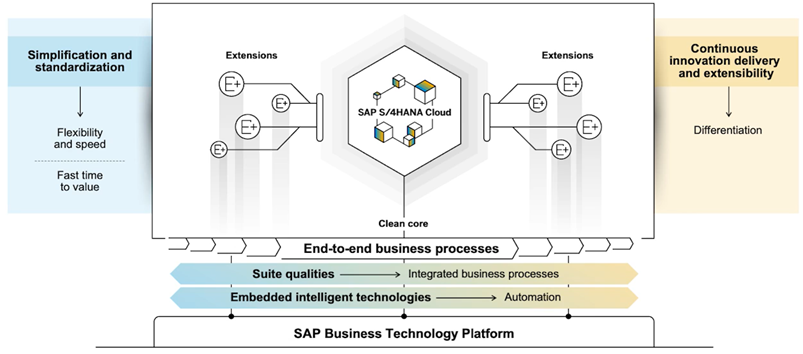
Broadly speaking, these solutions can be positioned from left to right as seen in the image:
- The solutions on the left are simpler, more standardised, well suited for quick implementation and, thus, deliver quick benefits for your business.
- The solutions on the right offer more options for differentiation and innovation as part of your ERP processes. Common to all of them is extended support for integrated business processes and a significant increase in automation in repetitive routine tasks (robotics) requiring event-based data (AI, machine learning).
- The SAP BTP Business Technology Platform is a cost-effective and highly compatible platform for all S/4HANA solutions for running interfaces, APIs, IoT connections, data storage and application modifications (cloud-native). Other cloud-based platform solutions are also available as alternatives to BTP.
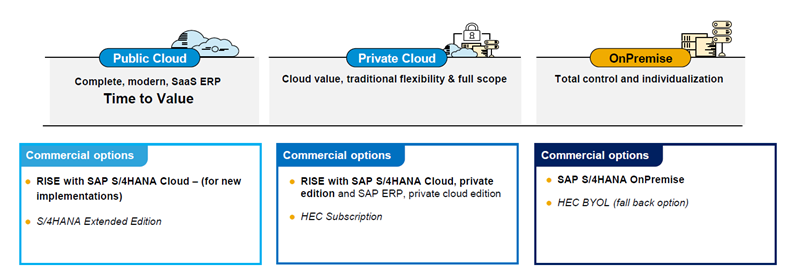
Generally, the products in the above images from left to right are also the most to least standardised ERP packages in the same respective order:
- The Cloud Edition on the left is a robust, complete suite maintained by SAP, and no modifications to the core product are permitted.
- On the right is the on-premise version, which is still the most used in Finland and also supports cloud installation. Many of the existing ABAP coded customisations are supported, and modification is possible.
- If you know how to configure S/4HANA on-premise solutions and are certified to do so, you can do the same with these cloud-based solutions (Essentials is configured via Fiori).
The core of SaaS (Software as a Service) licensing for cloud-based solutions is flexibility. Under this licence model, high usability of infrastructure and the application layer, data security, the usage rights model, Solman, monitoring, alerts and mandatory technical enablers are included in the price. A partner is required with SAP during the projecting phase and in maintenance, but the partner’s role is reduced furthest in this option.
As billing is based on event-based, easy-to-audit threshold values, SaaS contracts are easily and quickly scalable into larger volumes.
- SaaS licences are usually fixed for the duration of the contract period (often three years) and extensions may always be purchased, but there is no flexibility downwards. In negotiations, be aware of how contract changes (Curve-out) are realised in the event of an acquisition, for example. Usually, this is impossible until the end of the agreed licence period, or the stopping cash flow can be directed to a different replacement SAP product or service such as LoB, reporting, integrations, etc.
- When moving to the Any Premise version, existing on-premise licences can be converted to S/4HANA licences. Regarding such licensing, one must still remember the restrictions on indirect application use and client or supplier access to the S/4HANA Any Premise version.
Summary of SAP S/4HANA cloud and on-premise solutions
Table 1: Implementation and differences in licensing and maintenance
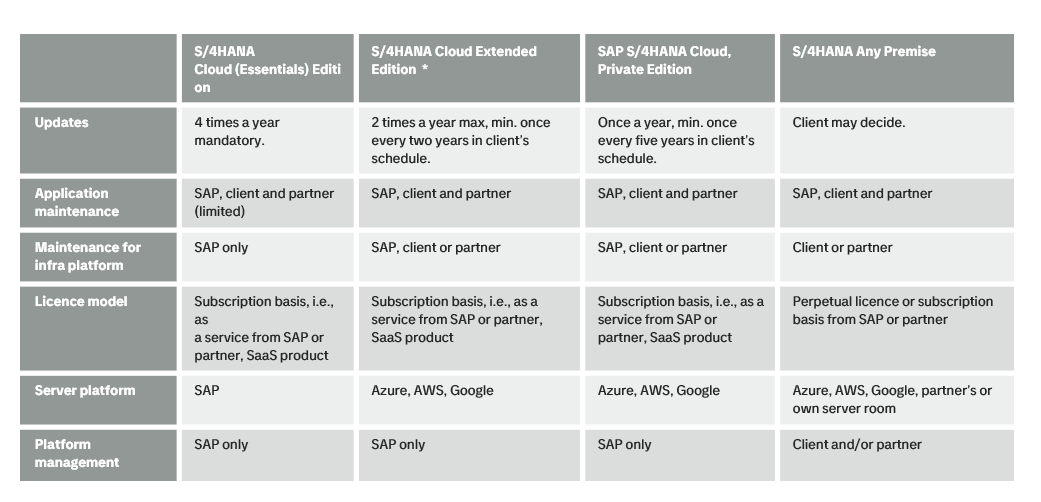
* SAP S/4HANA Cloud, extended edition is not available for new customers from 25th Jan 2022. Still available for upsell/renewals. The replacement will be called SAP Extended Services for SAP S/4HANA Cloud, private edition.
As the comparison indicates, the Cloud (Essentials) Edition is clearly SAP’s answer to true multi-tenant ERP solutions such as Oracle, Infor and Microsoft. It should be noted that the Cloud (Essentials) Edition includes much more functionality than its little brother, the SAP Business by Design version for small businesses.
Table 2: Modification management differences
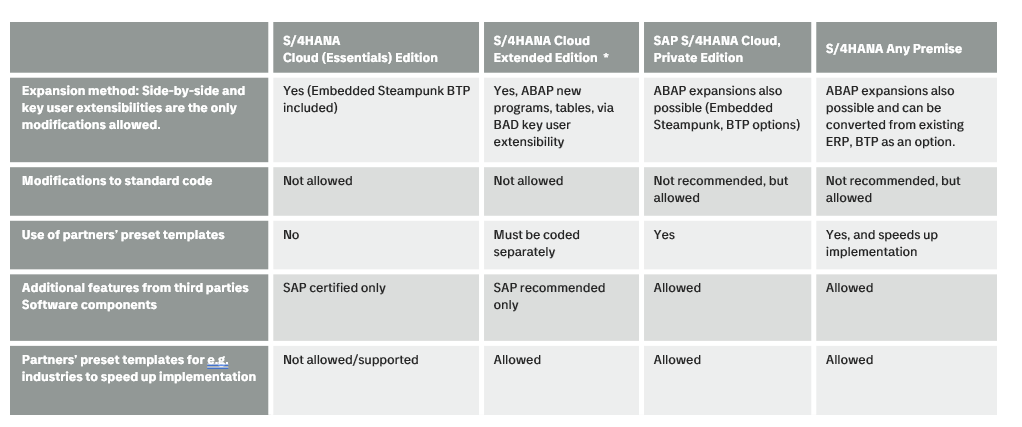
* SAP S/4HANA Cloud, extended edition is not available for new customers from 25th Jan 2022. Still available for upsell/renewals. The replacement will be called SAP Extended Services for SAP S/4HANA Cloud, private edition.
The main differences are found in modification and expansion permissions. The S/4HANA Cloud Extended Edition, S/4HANA Private Cloud and S/4HANA Any Premise are more open to the client, with more flexibility for modifications.
- All SAP ECC-compliant modules with new features are available, including pre-configured Best Practise templates for 64 countries.
- Built-in analytics and the Fiori experience are included in all and can be modified with key user features.
- Data can be sent or received as part of the standard process, utilising pre-built open APIs.
- IaaS or cloud platform as a service, Azure, AWS, GCP, etc.
- SingleTenant, a dedicated client-specific cloud environment.
- In our experience, shared use of the SAP – MES-Manufacturing Execution System, for example, may require partner-coded functionalities in S/4HANA, which are impossible to implement even in the S/4HANA Cloud Extended Edition.
Table 3: Implementation and difference in maintenance tools
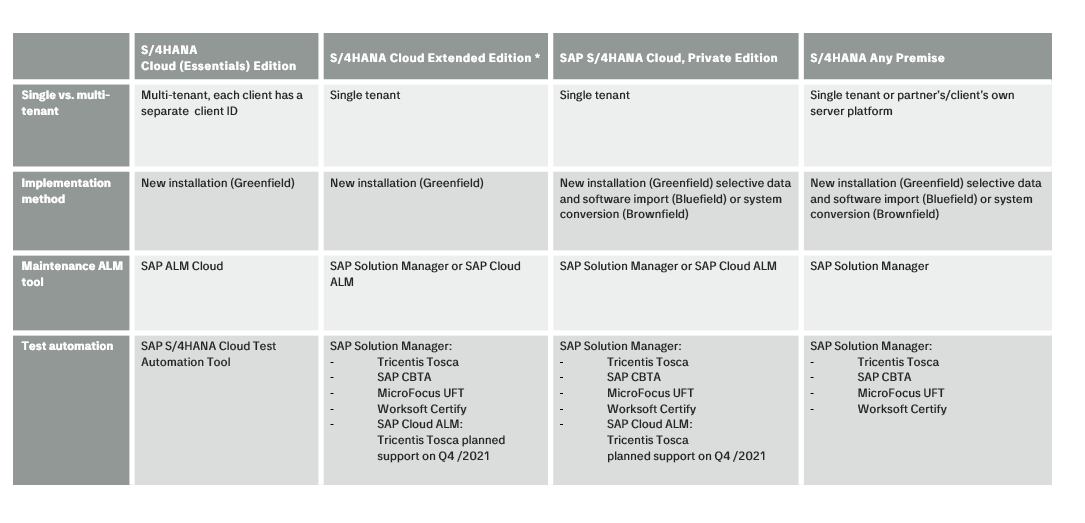 * SAP S/4HANA Cloud, extended edition is not available for new customers from 25th Jan 2022. Still available for upsell/renewals. The replacement will be called SAP Extended Services for SAP S/4HANA Cloud, private edition.
* SAP S/4HANA Cloud, extended edition is not available for new customers from 25th Jan 2022. Still available for upsell/renewals. The replacement will be called SAP Extended Services for SAP S/4HANA Cloud, private edition.
Only the SAP S/4HANA Cloud, Private Edition and S/4HANA Any Premise versions support transferring critical business ABAP applications to the new version. The suitability of ABAP customisations must be tested using Brownfield conversion tools, such as the simplification list. In addition, data transfer from an existing ECC version is possible via conversion or extraction in software. TietoEVRY’s SNP partner solution for a Bluefield method is an option.
Table 4: Database and operative system modification and access differences
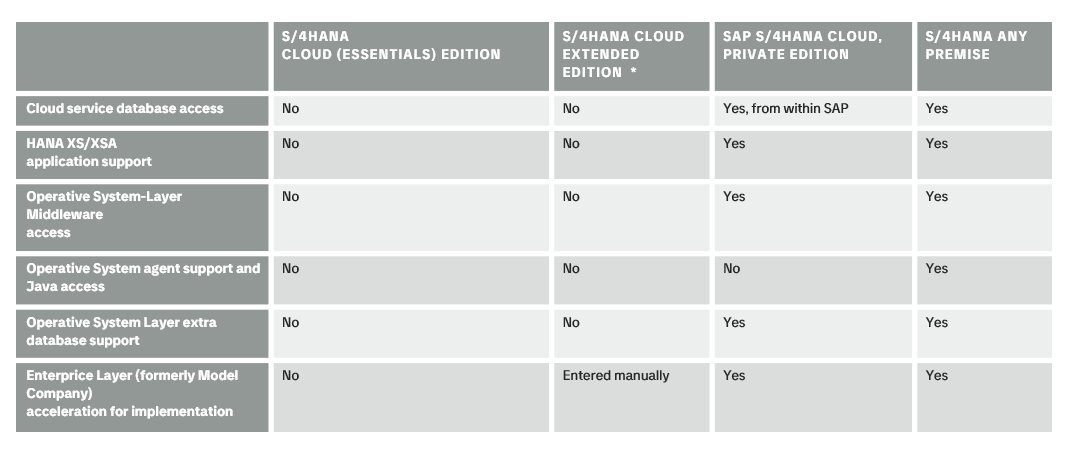
* SAP S/4HANA Cloud, extended edition is not available for new customers from 25th Jan 2022. Still available for upsell/renewals. The replacement will be called SAP Extended Services for SAP S/4HANA Cloud, private edition.
The S/4HANA Cloud (Essential) Edition is a more standardised SAP system, only implemented in a new Greenfield install. In terms of modifications on the operating system level, the Private and Any Premise products are the most flexible.
Important! The separately available Model Company options for speeding up implementation were briefly pulled from the market by SAP. Now, they are returning under a new name: Enterprise Layer. The S/4HANA Private Cloud and S/4HANA Any Premise offers 25 pre-configured industry templates.
We recommend
The S/4HANA Cloud (Essentials) Edition can be recommended to small and medium businesses as an ERP suite, like the Oracle Netsuite or Microsoft 365. However, SAP includes more features than its competitors right out of the box in 2021. This is also a solid option for larger businesses in search of so-called Administrative ERP, meaning only the basic selling, buying and wider business functionality are located in the ERP and e.g. core production processes (MES) operate elsewhere. In addition, this can be recommended as a multi-ERP strategy when more extensive SAP S/4HANA products are not needed in other countries due to their size.
The S/4HANA Cloud Extended Edition can be safely recommended to large businesses, as long as the differences to existing ERP functionality are carefully identified while understanding how to build missing features as a native cloud solution, for instance. A solid understanding of SAP’s roadmap for the coming years is also highly recommended. Scalability and high infra use are a target of constant development for platform partners, even in the future. In addition, the Extended Edition suits both new and current SAP clients, provided that the client is prepared for implementation via a new Greenfield install and discarding their own ABAP modifications.
The SAP S/4HANA Cloud Private Edition can be recommended to all large and small businesses whose cloud strategy is already clear but who have not yet decided on or implemented their final application standardisation level or application enablers required for competitiveness. This version ensures scalability and the use of existing ABAP applications in the future, alongside the conversion of existing history data as part of your new solution.
The S/4HANA Any Premise version can be recommended to businesses looking for a quick transition to the S/4HANA ERP age with minimal risks and without immediate changes to their operations. In the short term, this version can be the cheapest way by far to update your licences and database to a S/4HANA version, and thus this version can offer additional time for your final SAP suite in the cloud, on-premise or as a hybrid.
The Any Premise version carries over existing critical ABAP functionalities, and the SAP GUI can also remain as the user interface. Naturally, this version can also be used as a template for a modification project by a larger business looking to upgrade their operations with S/4HANA capabilities.
How are expansions and customisation done?
Within the cloud-based solutions, traditional expansions can still be implemented according to our recommendations:
- Modernise your existing ABAP software: Turn your existing software components into Cloud Native software for more cost-effective maintenance in the future and improved integration opportunities.
- Be sure to utilise SAP S/4HANA’s public API expansion interfaces — in the future, these will be your only access to the core system.
- Side by Side expansions works most easily in SAP’s proprietary Business Technology Platform.
- When you want to expand, the Extended and Essentials versions offer three options:
- In-app extensibility: Use SAP tools designed for key users. This is well suited for UI or standard report modification, such as screen modifications.
- Side-by-side “Embedded Steampunk” extensions: When your specific need is close to the SAP S/4HANA data model, SAP has introduced the new “Embedded Steampunk” for ABAP as part of BTP, utilising a cloud connector. By using this, you avoid standard code violations and ensure you will continue to receive updated versions in the future.
- Private Cloud and S/4HANA Any Premise: The traditional Z-ABAP and side extensions, cloud-native programs (Azure, AWS, Google)
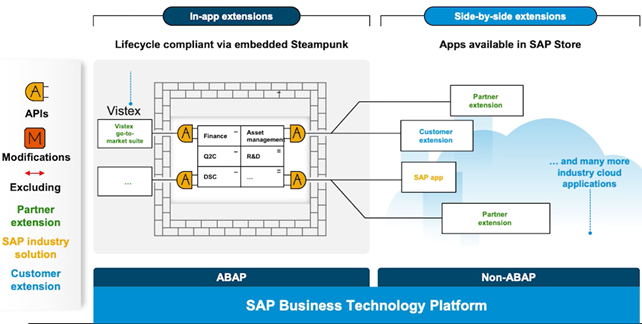
Benefits of a cloud solution
In all cloud-based solutions, the client benefit should be a lower life cycle TCO (total cost of ownership) compared to the old ECC. This comes in the form of cheaper implementation of faster SAP product features, directly benefitting the business, but also as lower costs in terms of maintenance, such as infra, development, safety and personnel costs.
Our view supports the SAP objective, according to the attached image:
- The most common and therefore similar client processes are HR, business, procurement and purchasing. These processes see the largest number of benefits from Best Practise and automation, also via the mandatory continuous versions from SAP.
- Processes that improve the competitiveness and individuality of businesses are more challenging in terms of staying with the S/4HANA standard version.

Industry-specific innovations will become part of the basic solutions, but the extra feature options under the Enterprise Layer name (formerly Model Company) will remain.
Read more about starting your S/4HANA journey and trip tips here.
If you’d like to hear more, get in touch!


